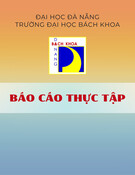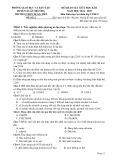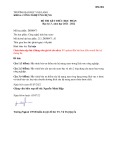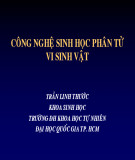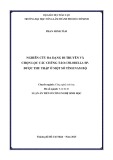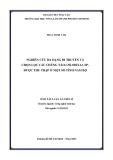J. Sci. Dev. 2011, 9 (Eng.Iss. 1): 55 - 62 HANOI UNIVERSITY OF AGRICULTURE
EFFECT OF MANGROVE FOREST STRUCTURES ON SEA WAVE ATTENUATION IN VIETNAM
Ảnh hưởng của cấu trúc rừng ngập mặn đến quy luật giảm chiều cao sóng biển ở Việt Nam
Tran Quang Bao1, Melinda J. Laituri2
1 Vietnam Forestry University 2 Warner College of Natural Resources, Colorado State University, Fort Collins, CO 80523, USA Corresponding author email: baofuv@yahoo.com Received date: 15.03.2011 Accepted date: 03.04.2011
TÓM TẮT
Bài báo phân tích quy luật giảm chiều cao sóng ở rừng ngập mặn ven biển Việt Nam. Số liệu nghiên cứu được thu thập từ 32 ô tiêu chuẩn trên hai vùng sinh thái khác nhau. Trên mỗi ô tiêu chuẩn, tiến hành đo đếm cấu trúc rừng ngập mặn và chiều cao sóng biển khi đi sâu vào các đai rừng ngập mặn ở các khoảng cách khác nhau. Kết quả nghiên cứu cho thấy, chiều cao sóng biển có liên hệ chặt với khoảng cách đi sâu vào đai rừng theo dạng phương trình hàm mũ (P val. <0,00; R2>0,95). Quy luật giảm chiều cao sóng biển phụ thuộc vào các biến: chiều cao sóng ban đầu, khoảng cách đi sâu đai rừng và cấu trúc rừng ngập mặn. Phương trình liên hệ này đã được sử dụng để xác định bề rộng đai rừng ngập mặn tối thiểu cho phòng hộ ven biển Việt Nam.
Từ khoá: Cấu trúc rừng, đai rừng ngập mặn, giảm sóng biển, rừng ngập mặn.
SUMMARY
This paper analyzes wave attenuation in coastal mangrove forests in Vietnam. Data from 32 mangrove plots of six species located in 2 coastal regions are used for this study. In each plot, mangrove forest structures and wave height at different cross-shore distances are measured. Wave height closely relates to cross-shore distances. Ninety one exponential regression equations are highly significant with R2 > 0.95 and P <0.001. Wave height reduction depends on initial wave height, cross-shore distances, and mangrove forest structures. This relationship is used to define minimum mangrove band width for coastal protection from waves in Vietnam.
Key words: Forest structures, mangrove forest, mangrove band width, wave attenuation.
1. INTRODUCTION
recently been documented
sciences have in mangrove forest areas in Vietnam (Thompson et al., 2009). The trunks and roots above the ground of mangrove forests have a considerable influence on the hydrodynamics and sediment transport within forests (Quartel et al., 2007). In 2002, Vietnam had approximately 155,290 ha of mangrove forests. More than 200,000 ha of mangrove forests have been destroyed over the last two decades by conversion to agriculture and aquaculture (e.g., shrimp farming) as well as by development for recreation (VNEA, 2005). Mangrove forests are Mangrove forests span the interface between marine and terrestrial environments, growing in the mouths of rivers, in tidal swamps, and along coastlines where they are regularly inundated by salty or brackish water (Sterling et al., 2006). Mangrove forests play a vital role in coastline protection, mitigation of wave and storm impacts and mudflats stabilization, and protection of near shore water quality. They also provide critical habitat for fish and wildlife. Many species new to
55
Effect of mangrove forest structures on sea wave attenuation in Vietnam
thought to play an important role in flood defense by dissipating incoming wave energy and reducing the erosion rates (Hong et al., 1993; Wu et al., 2000). However, the physical processes of wave attenuation in mangroves have been not widely in Vietnam, because of studied, especially difficulties in analyzing the flow field in the vegetation field and the lack of comprehensive data (Kobayashi et al., 1993).
the Australia flyways. In (2005) highlighted
site is located in the Red River delta, that is the second largest delta in Vietnam and flows into the Bay of Tonkin (Fig. 1). The tides in the Bay of Tonkin are diurnal with a range of 2.6 - 3.2 m. Active intertidal mudflats, mangrove swamps and supratidal marshes in estuaries and along open coastlines characterize the coastal areas (Mather et al., 1999; Quartel et al., 2007). Mangrove in the Red river delta is one of the main remaining large tracts of mangrove forest in Vietnam, which are important sites for breeding/stop-over along the East-Asian or this northern region, four mangrove locations were selected for the research, including Tien Lang and Cat ba of Hai Phong; Hoang Tan of Quang Ninh; and Tien Hai of Thai Binh. In each of location, four mangrove forest plots were set up to measure mangrove structure and wave height at different cross-shore distances.
Coastal mangrove forests can mitigate high waves, even tsunamis. By observing causalities of the tsunami of December 26, 2004, Kathiresan et al., the effectiveness of mangrove forest in reducing the impact of waves. Human death and loss of wealth decreased with areas of dense mangrove forests. A review by Alongi (2008) concluded that significant reduction in tsunami wave flow pressure when mangrove forest was 100 m in width. The energy of wave height and wave spectrum is dissipated within mangrove forest even at small distance (Luong et al., 2008). The magnitude of energy absorption strongly depends on mangrove structures (e.g., density, stem and root diameter, shore slope) and spectral characteristics of incident waves (Massel et al., 1999; Alongi, 2008). The dissipation of wave energy inside mangrove forests is mostly caused by wave-trunk interactions and wave breaking (Luong et al., 2006).
that
for migratory
The southern study site was Can Gio mangrove forest. It is the first Biosphere Reserve in Vietnam located 40 km southeast of Ho Chi Minh City and has a total of 75,740 ha (Fig. 1). Can Gio lies in a recently formed, soft, silty delta with an irregular, semi-diurnal tidal regime (Luong et al., 2006). The major habitat types in Can Gio are plantation mangrove, of which there is about 20,000 ha, and naturally regenerating mangrove. The site is an important wildlife sanctuary in Vietnam as it is characterized by a wetland biosystem dominated by mangrove. The intertidal mudflats and sandbanks at Can Gio are an important habitat shorebirds. Eighteen mangrove forest plots were set up in Can Gio to collect data of mangrove structures and wave height. These plots are selected representative for differences in mangrove structure in the region (e.g., age, species, height, tree density).
2.2. Data Collection
Mazda et al. (1997a) on their study in the Red River Delta, Vietnam showed the wave reduction due to drag force on the trees was significant on high density, six-year-old mangrove forests. Hydrodynamics in mangrove swamps changes in a wide range with their species, density and tidal condition (Mazda et al., 1997b). High tree density and above ground roots of mangrove forest cause a much higher drag force of incoming waves than the bare sandy surface of the mudflat does. The wave drag force can be expressed in an exponential function (Quartel et al., 2007).
2. MATERIALS AND METHODS
The general objective of this paper is to analyze the relationship between wave height and mangrove forest structures, and then to define minimum mangrove forest band width for coastal protection from waves for coastline of Vietnam.
2.1. Study Sites
A total 32 mangrove forest plots were set up in five locations of two regions along coastal Vietnam. In each plot of 400 m2 (20 m x 20 m), about 2-5 routes are designed to measure wave height at different cross-shore distances (i.e., 0 m, 20 m, 40 m, 60 m, 100 m, and 120 m) from the edge to the center of the mangrove stand (Fig. 2). The numbers of measurable replications in each route were from 2 to 10. Mangrove forest structures, such as breast-height diameter, height, tree density, canopy closure and species were collected in each plot. Wave attenuation was analyzed in relation to distances, initial wave height and mangrove forest structures. The study was conducted in two coastal mangrove forests of Vietnam. The northern study
56
Tran Quang Bao, Melinda J. Laituri
Tonkin Bay
(a)
-
Legend
Research Area
Vietnam
0
30
60 120 180 240
Kilometers
(b)
Figure 1. Map of Vietnam showing the location of study areas (a) Sonneratia caseolaris forest in Hai Phong, and (b) Rhizophora mucronata forest in Ho Chi Minh City.
Figure 2. A diagram designed to measure wave height on a cross shore transect
57
Effect of mangrove forest structures on sea wave attenuation in Vietnam
3. RESULTS AND DISCUSSION
3.1. Effect of Mangrove Structures on Wave Height trucks, branches and above ground roots of the mangrove trees increasing bed roughness and causing more friction and dissipating more wave energy (Quartel et al., 2007).
wBb
The effect of mangrove forest band width on wave height can be generalized in an exponential equation (1)
eaW
**=
h
(1)
Where:
Wh is the sea wave height behind forest band (cm)
The structures of 32 mangrove forest plots in five coastal research areas are relatively simple. There are only six dominant species (i.e., Rhizophora mucronata; Sonneratia caseolaris; Sonneratia griffithii; Aegiceras corniculatum; Avicennia marina; Kandelia candel) with high tree density (2000 ÷ 13000 trees ha-1) and canopy closure averaging above 80%. Diameter and height ranges from 7.5 to 12 (cm) and 1.6 to 11.3 (m), respectively. Generally, DBH and height of mangrove forests increases toward the south. It may be explained by the differences in resources supply (i.e., more mudflats, and warmer climate in the south). Average wave height observed in all plots ranges from 20 to 70 (cm).
BBw is the forest band width (m) a is intercept in log base e of equation (1) b is slope coefficient in log base e of equation (1) To establish a general equation for all measurements in five locations, from the data listed in 92 regression coefficients of equation (1) we analyze the relation of these coefficients (i.e., intercept and slope) with different independent variables. We have found interesting results of relationship of regression coefficients to initial wave height and mangrove forest structures:
60
50
From the data on wave height (cm) measured at different distances (m) from the edge to the center of the mangrove stand, we applied regression models to inspect the relationship between wave height and cross-shore distances to the forest. The results show that wave height decays exponentially and is significantly related to distances. All 92 exponential regression equations of five research areas with different mangrove forest species are highly significant with P values of <0.001 and R2 > 0.95. The exponential reduction of wave height in mangroves can be explained by dense network of 1) Intercept coefficient (a) is highly correlated to initial wave height (i.e., wave height at the edge of mangrove forest, distance= 0), R2=0.989, P <0.0001. It is a linear equation, in which a coefficient is directly proportional to initial wave height.
)
Wh = 24.941e-0.01*Bw R2 = 0.993 Wh = 14.289e-0.0067*Bw R2 = 0.972 Wh = 54.801e-0.0168*Bw R2 = 0.998 Wh = 27.154e-0.0055*Bw R2 = 0.981
40
Cat ba
Hoang Tan
30
Can gio
Tien lang
20
m c ( t h g i e H e v a W a e S
10
0
0
20
40
60
80
100
120
Forest Band Width (m)
Figure 3. The reduction of wave height by cross shore distances. Examples from measured data of route 1 and the first replication of plots in Cat Ba, Hoang Tan, Can Gio, Tien Lang, respectively
58
Tran Quang Bao, Melinda J. Laituri
90
)
80
70
60
i
50
40
30
m c ( t h g e H e v a W a e S
l
20
a i t i n
10
I
0
0
20
40
60
80
100
a coefficient
60
50
Figure 4. Bivariate plots of coefficient a in equation (1) and initial wave height (cm)
R2 = 0.81; RSME = 3.93cm
45
R2 = 0.93; RSME = 2.54cm
50
40
)
)
35
40
30
30
25
20
20
15
m c ( t n e m e r u s a e M
m c ( t n e m e r u s a e M
10
10
5
0
0
0
10
20
30
40
0 5
0
0
10
20
30
40
5
Prediction (cm)
Prediction (cm)
(a) (b)
Figure 5. Bivariate plots of predictive and actual values of wave height (cm) at two distances from the edge to the center of forest (a) distance = 40m; (b) distance = 80m
a = 0.9899*Iwh + 0.3526
(2) Where: a is the coefficient in the exponential equation (1)
W
0.9899*I
=
+
By plugging two equations (2) and (3) into the equation (1), we have an integrated equation (4) demonstrating the relationship of wave height reduction to initial wave height and mangrove forest structure.
) 0.3526 *
h
wh
0.048- 0.0016*H -0.00178*Ln(N) - 0.0077*Ln(CC) *Bw
(
)
(4)
( *e
Iwh is the initial sea wave height (cm) 2) Slope coefficient (b) is in regression with mangrove forest structures, about 71% of total variations of b coefficient is associated with height, density, and canopy closure (R2 = 0.713, P<0.0001). These independent variables are inversely related to the exponential coefficient of equation (1).
0.0077 * Ln(CC) b = 0.048 - 0.0016 * H - 0.00178 * Ln(N) - (3) Where: b is the exponential coefficient in the equation (1)
predictions 2.54cm and are To validate the accuracy of the model (4), the predicted values are compared with actual data. Fig. 5 (a, b) shows a high correlation between predicted wave height and observed wave height at two cross-shore distances of 40m and 80m (R2>0.8). The root squared mean errors (RSME) of the 3.93cm, respectively. H is th average tree height (m) N is the tree density (tree ha-1) CC is the canopy closure (%)
59
Effect of mangrove forest structures on sea wave attenuation in Vietnam
wave height to calculated minimum mangrove band width for coastal protection. 3.2. Minimum Mangrove Band Width for Coastal Protection from Waves
from cross-shore distance
)
ln(
peasants, managers) working Safe wave height behind forest band in equation (5) is 30cm, it is the averagedg value of wave height by interviewing 50 people (e.g., in farmers, aquaculture and agriculture in research areas.
a
W
h
B
=
w
The integrated equation (4) is the prediction of wave height (i.e., mangrove band width), mangrove structures, and initial wave height. Mangrove band width is identified by equation (5) derived from equation (4). In the equation (5), for a given predicted wave height (i.e., safe wave height) and initial wave height, the mangrove band width depends on the mangrove forest structures. ln( (5) By plugging the values of initial wave height (300cm), and safe wave height (30cm) into equation (5), as a result, the required mangrove band width (BBw) is only a function of forest structure index depending on height, density, and canopy closure (equation 3).
+ 0.0077*ln(CC)]
Let V = - b = [- 0.048 + 0.0016 *H + 0.00178*ln(N) (6) Where V is an index of mangrove forest structure. A theoretical line of minimum forest band width in relation to vegetation index is demonstrated in Fig. 6.
) − b Where: Bw is forest band width (m) Wh is safe wave height behind forest band (cm) a is a function of initial wave height (equation 2) b is a function of forest structure (equation 3) To identify average initial wave height for equation (5), we have collected maximum wave height at different typical regions along coastline of Vietnam (Table 1). In two years from 2004 to 2005, the maximum wave height approximately ranged from 1.25m to 5.0m. In reality, wave height depends on the characteristics of storm events. Wave height is caused by strong wind and heavy rain, whereas in normal weather wave height is usually low in Vietnam. We selected a threshold of 3m of maximum
The index of mangrove structure is classified into 5 levels of wave prevention based on its relation to wave height (Fig. 6; Table 2). Required mangrove band width decays exponentially by vegetation index (V). When mangrove forest is tall, dense, and has high canopy closure (i.e., high V index), a narrower forest band is required. In contrast, when mangrove forest is short, low tree density and of low canopy closure (i.e., low V index), a wider mangrove band is required.
Regions
Hai Phong Quang Ninh Vung Tau Thanh Hoa Da Nang
6h30 2.97 1.25 1.25 0.75 3.50
Maximum sea wave height (m) 12h 30 3.69 1.25 125 1.35 5.00
17h 00 3.60 1.50 1.50 1.50 3.50
* Sources: Department of Hydrometeorology, observed from Jan 01, 2004 to Dec. 31, 2005
700
)
600
t
i
500
400
Table 1. Maximum Sea Wave Height in coastal Vietnam
I
300
II
200
III
100
IV
V
0 0.000
0.005
0.010
0.015
0.020
0.025
0.030
0.035
0.040
m m) ( ( h h dt d Wi W d n d a B n a st B e or t F s d e e r r o ui F q e R d e r i u q e R
Forest Structure Index (V)
Figure 6. Theoretical curve showing relationship between mangrove structure index (V) and mangrove band width (m)
60
Tran Quang Bao, Melinda J. Laituri
Name of levels
ention
vention
Levels I II III IV V
V index < 0.005 0.005 – 0.010 0.010 – 0.015 0.015 – 0.028 > 0.0280
Required Band Width (m) > 240 120 - 240 80 - 120 40 - 80 < 40
very weak prev weak pre moderate prevention strong prevention very strong prevention
* Maximum wa
ve height is assumed 300
cm
Table 2. Classification of mangrove forests for preventing sea waves
Dominant Species
No. 1
Locations Cat Ba
a
2
Can Gio
3
oang Tan
H
4
Thai Binh
V index 0.00484 0.01408 0.01631 0.01374 0.00587 0.00474 0.00318 0.00749 0.00242 0.00504
Level I III IV III II I I II I II
5
Tien Lang
laris
Aegiceras corniculatum Avicennia marin Rhizophora mucronata aris Sonneratia caseol Sonneratia caseolaris Avicennia marina Aegiceras corniculatum Kandelia candel Aegiceras corniculatum Sonneratia caseo
* V: inde
x of mangro
ve st
ructure
Table 3. Index of Mangrove Structu res and Corresponding Level of Wave Prevention
4. CONCLUSIONS
- Level 1: V index is less tha en V index is increasing. Th are very forests Mangrove n 0.005, in this e minimum grove band width is decreasing quickly from level wh man 600m to 240m.
- Level 2: V index is ranging from 0.005 to 0.015. In this level the increasing of V index causes inimum band width fairly quickly decreasing the m from 240m to 120m.
- Level 3: V index is ranging from 0.010 to 0.015. In this level, the increasing of V index results in a gradually decreasing of minimum band width from 120m to 80m. important ecosystems located in the upper intertidal zones of the tropics. They are the primary source of energy ents. They have a and nutrients in these environm special role in stabilizi ng shorelines, minimizing damage, and trapping sediments. However, in wave recent decades mangrove forests in Vietnam are threatened by conversion to agriculture and aquaculture. The primary objectives of this study were to define minimum mangrove band width for coastal protection from waves in Vietnam.
2
- Level 4: V index is ranging from 0.015 – V index in this level 0.028. The increasing of results in a slowly decreasing of minimum band width from 40m to 80m.
We have set up 32 plots in 2 coastal regions of Vietnam to measure wave attenuation from the edge to the center of forest (distances). The results show that wave height closely relates to cross-shore distances in an exponential equation. All single equations are highly significant with P <0.001 and R >0.95.
in
We have established an integrated exponential equation applied for all cases, in which a coefficient (i.e., intercept in log transformation of exponential equation) is a function of initial wave log height, and b coefficient (i.e., slope transformation of exponential equation) is a function of canopy closure, height, and density. The integrated equation was used to define appropriated - Level 5: V index is greater than 0.028. The increasing of V index causes a minimal decreasing of m inimum band width always less than 40m. Applying the threshold of V index in Table 3, we have identified the levels of wave prevention for 32 mangrove forest plots. The results show that the levels of wave prevention of southern plots about 3÷4 are higher than those of northern plots about 1÷2. This indicates that the southern mangrove forest can protect coastline better than the northern mangrove forest does (Table 3).
61
Effect of mangrove forest structures on sea wave attenuation in Vietnam
earch. 24, 219-249. (1999). Surface wave propagation in mangrove forests. Fluid Dynamics Res
mangrove band width. With the assumption that the average maximum wave height is 300cm and safe wave height behind forest band is 30cm, required mangrove forest band width in associated with its structures was defined. Mathers, S., and J. Zalasiewicz (1999). Holosence sedimentary architechture of the Red River Delta, Vietnam. Journal of Coastal Research, 15 (2), 314-325.
REFERENCES
Mangrove structure index (V) is classified into 5 levels of protection waves. The southern mangrove forests of Vietnam protect waves better than the northern mangrove forests do (i.e., higher V index). Mazda, Y., M. Magi, M. Kogo, and P.N. Hong (1997). Mangroves as a Coastal Protection from Waves in the Tong King Delta, Vietnam. Mangroves and Salt Marshes, 1, 127-135.
Alongi, D. M. Mazda, Y., E. Wolanski, B. King, A. Sase, D. Ohtsuka, and M. Magi (1997). Drag Force due to Vegetation in Mangrove Swamps. Mangroves and Salt Marshes, 1, 193-199. (2008). Mangrove from
forests: tsunamis, and Resilience, protection responses to global climate change. Estuarine Coastal and Shelf Science. 76, 1-13. Hong, P.N., and
St Ka -21 and pp. 91-92. Quartel, S., A. Kroon, P.G.E.F. Augustinus, P. Van Santen, and N.H.Tri (2007). Wave Attenuation in Coastal Mangroves in the Red River Delta, Vietnam. Journal of Asian Earth Sciences. 29, 576-584. erling, J. E., M.M. Hurley, and D.L.Minh (2006). Vietnam: A Natural History, Yale University Press, pp. 1 H.T. San (1993). Mangroves of Vietnam. IUCN, Wetland Programme, Bangkok, Thailand, 158pp. thiresan, K., and N.Rajendran (2005). Coastal mangrove forests mitigated tsunami. Estuarine Coastal and Shelf Science. 65, 601-606.
Theobald, D.M. (2003). GIS Concepts and ArcGIS Methods. 1st Edition, Conservation and Planning Technologies Publisher, USA. pp. 238-266.
Lu www.panda.org/greatermek
Vi
Lu
W Southern forest,
., K. Furukawa, and R.M. Brinkman M Kobayashi, N., A. W. Raichle, and T. Asano, (1993). Wave Attenuation by Vegetation. Journal of Waterway, Port, Coastal, and Ocean Engineering. 119 (1), 30-48. ong, V. H. P., and S. R. Massel (2008). Energy disspation in non-uniform mangrove forests of arbitrary depth. Journal of Marine Systems. 74, 603-622. ong, V. H. P., and S. R. Massel (2006). Experiments on wave motion and suspended sediment concentration at Nang Hai, Can Gio Vietnam. mangrove Oceanlogia, 48 (1), 23-40. assel, S. R Thompson, C., and T. Thompson (2008). First Contact in the Greater Mekong: new species ong. discoveries. Cited 10/10/2009. etnam Environment Protection Agency - VEPA (2005). Overview of Wetlands Status in Vietnam s of Ramsar Convention Following 15 Year Implementation. u, Y., R.A. Falconer, and J. Struve (2001). Mathematical Modelling of Tidal Currents in ts. Environmental Modelling Mangrove Fores Software. 16, 19-29.
62



